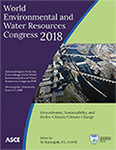World Environmental and Water Resources Congress 2018
Linear Regression Analysis and Statistical Models Using Oceanic and Atmospheric Variables for Streamflow Forecasting in Chixoy River, Guatemala
Publication: World Environmental and Water Resources Congress 2018: Groundwater, Sustainability, and Hydro-Climate/Climate Change
ABSTRACT
The objective of this study is to forecast streamflows in the Chixoy River Basin, Guatemala. The basin covers an area of about 5,000 km2, it is located upstream of the Usumacinta River which drains into the Mexican Gulf, and it was selected as case study because it supplies the main hydropower plant of the country. Based on teleconnection principles and linear multiple regression analysis, statistical models were performed. The independent variables were oceanic and atmospheric indices used for monitoring El Niño South Oscillation (ENSO) by the National Weather Service/Climate Prediction Center of the National Oceanic and Atmospheric Administration (NOAA). These variables include sea level pressures (SLP), southern oscillation index (SOI), sea surface temperatures (SST), and trade winds (TW) in different regions of the Tropical Pacific Ocean, as well as autocorrelation of the river flows. The dependent variable was the seasonal (three-monthly average) river flow into the hydropower reservoir Chixoy for the period 1980–2009, which was operated by the Guatemalan National Electrification Institute (INDE in Spanish). The models were assessed through multiple step-wise regression analysis and cross correlations lagged from 1 to 12 months. To appraise the forecast potential of the model, cross validation was performed where the correlation coefficient, the difference between the forecast and the observed river flow, and the standard error were evaluated. In addition, the Durbin-Watson test was applied to verify that there was no autocorrelation on residuals. Six models were developed for the trimesters September-October-November (r2=0.803); October-November-December (r2=0.748); November-December-January (r2=0.818); December-January-February (r2=0.800); January-February-March (r2=0.820); and February-March-April (r2=0.855).
Get full access to this chapter
View all available purchase options and get full access to this chapter.
REFERENCES
Bertacchi Uvo, C. & Graham, N.E. (1998). “Seasonal runoff forecast for northern South America: A statistical model.” Water Resources Research, 34 (12), 3515–3524.
Caviedes, C.N. (1998). “Influencia de ENOS sobre las variaciones interanuales de ciertos ríos en América del Sur.” Bull. Inst. fr. Études andines, 27(3), 627–641.
Compagnucci, R.H. & Araneo, D.C. (2006). “Identificación de áreas de homogeneidad estadística para los caudales de ríos andinos argentinos y su relación con la circulación atmosférica y la temperatura superficial del mar.” Meteorologicas, 30 (2), 41–53.
CPC (Climate Prediction Center), NWS (National Weather Service), NOAA (National Oceanic and Atmospheric Administration) “The ENSO Cycle” <http://www.cpc.ncep.noaa.gov/products/analysis_monitoring/ensocycle/enso_cycle.shtml> (Jan. 10, 2018).
Hastenrath, S. (1991). “Climate Dynamics of the Tropics”. Springer Science & Business Media.
Hastenrath, S. (1990). “Diagnostics and Prediction of Anomalous River Discharge in Northern South America.” Journal of Climate, 3, 1080–1096.
Instituto Nacional de Sismología, Vulcanología, Meteorología e Hidrología (INSIVUMEH) < http://www.insivumeh.gob.gt/ > (Jan 16, 2018).
McCuen, R.H., 2003. Modeling hydrological change: Statistical methods.CRC Press.
Poveda, G., Gil, M.M. & Quiceno, N. (1998). “El Ciclo Anual de la Hidrología de Colombia en Relación con el ENSO y la NAO.” < http://www.redalyc.org/articulo.oa?id=12627334 > (Jan. 10, 2018)
Information & Authors
Information
Published In
World Environmental and Water Resources Congress 2018: Groundwater, Sustainability, and Hydro-Climate/Climate Change
Pages: 280 - 286
Editor: Sri Kamojjala, Las Vegas Valley Water District
ISBN (Online): 978-0-7844-8141-7
Copyright
© 2018 American Society of Civil Engineers.
History
Published online: May 31, 2018
Authors
Metrics & Citations
Metrics
Citations
Download citation
If you have the appropriate software installed, you can download article citation data to the citation manager of your choice. Simply select your manager software from the list below and click Download.
